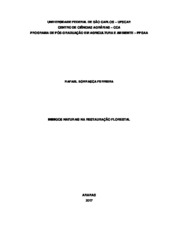Mostrar el registro sencillo del ítem
Inimigos naturais na restauração florestal
| dc.contributor.author | Ferreira, Rafael Borrasca | |
| dc.date.accessioned | 2018-07-10T19:08:56Z | eng |
| dc.date.available | 2018-07-10T19:08:56Z | eng |
| dc.date.issued | 2017-12-18 | eng |
| dc.identifier.citation | FERREIRA, Rafael Borrasca. Inimigos naturais na restauração florestal. 2017. Dissertação (Mestrado em Agricultura e Ambiente) – Universidade Federal de São Carlos, Araras, 2017. Disponível em: https://repositorio.ufscar.br/handle/ufscar/10268. | * |
| dc.identifier.uri | https://repositorio.ufscar.br/handle/ufscar/10268 | por |
| dc.description.abstract | Forest restoration is a global priority by make the reestablishment of ecosystem services. Many of these services have major importance on the agriculture fields, such as the pest control given by the predators and parasitoids fauna. In the search for a better understanding of the relation between natural pest control and the forest restoration, we aimed to: i) verify if the restoration process can increase the abundance, richness and diversity of natural enemies; ii) verify if these increases are exclusive to natural enemies or occurs with others arthropods; iii) compare attributes from the vegetation structure and the natural enemies community. The study was carried out in two different landscapes in São Paulo state, Araras and Itu. In each landscape, we selected a pasture, a younger, an intermediate and an older restoration planting, and a forest fragment. In September and October of 2016, five plots of 10x10m we replaced in each area for measuring tree density, sapling density and canopy cover. A pitfall trap was placed in the center of each plot for the passive arthropod survey and we used the beat sheet in the four trees nearest to the center of the plot for an active arthropod survey, we performed these surveys two times, one in the dry and the other in the rainy seasons. The richness and diversity of natural enemies enhanced by the process of restoration, and this enhance was higher for natural enemies than to arthropods in general. The abundance of natural enemies of restoration sites shows no difference to pastures and forest patches, but pasture shows less abundance than the forest, we didn’t found difference in the abundance of natural enemies and the other arthropods though this restoration chrono sequence. Canopy cover and tree densities were positively correlated to richness, diversity and abundance of natural enemies, showing that the forest structure reestablishment in the restoration areas can enhance the natural enemies community. | eng |
| dc.description.sponsorship | Coordenação de Aperfeiçoamento de Pessoal de Nível Superior (CAPES) | por |
| dc.language.iso | por | por |
| dc.publisher | Universidade Federal de São Carlos | por |
| dc.rights.uri | Acesso aberto | por |
| dc.subject | Controle natural de pragas | por |
| dc.subject | Restauração florestal | por |
| dc.subject | Serviços ecossistêmicos | por |
| dc.subject | Mata atlântica | por |
| dc.subject | Forest restoration | eng |
| dc.subject | Natural pest control | eng |
| dc.subject | Atlantic rainforest | eng |
| dc.subject | Ecosystems services | eng |
| dc.title | Inimigos naturais na restauração florestal | por |
| dc.title.alternative | Natural enemies on forest restoration | eng |
| dc.type | Dissertação | por |
| dc.contributor.advisor1 | Viani, Ricardo Augusto Gorne | |
| dc.contributor.advisor1Lattes | http://lattes.cnpq.br/3250752369062840 | por |
| dc.contributor.advisor-co1 | Fujihara, Ricardo Toshio | |
| dc.contributor.advisor-co1Lattes | http://lattes.cnpq.br/1863735094370774 | por |
| dc.description.resumo | A restauração florestal é uma prioridade global por restabelecer serviços ecossistêmicos. Um dos serviços de grande importância agrícola supostamente restabelecido pela restauração florestal é o controle natural de pragas, que ocorreria graças à ação da fauna de inimigos naturais que se estabeleceria nas áreas em restauração. No entanto, a relação entre a restauração florestal e o controle natural de pragas ainda é pouco estudada. Assim, este estudo teve como objetivos: i) verificar se o processo de restauração florestal proporciona o incremento nos índices da comunidade de inimigos naturais; ii) verificar se o aumento destes índices é exclusivo ou se o mesmo ocorre também para outros artrópodes e; iii) relacionar a estrutura da vegetação em restauração com os índices da comunidade de inimigos naturais. Foram avaliadas cinco condições (pastagem; áreas de restauração de três idades e fragmento de floresta nativa) em duas paisagens diferentes: Araras-SP e Itu-SP. Em cada condição e para cada paisagem, foram estabelecidas parcelas de 10x10m, nos quais foram quantificados, entre setembro e outubro de 2016, o número de árvores e regenerantes e a cobertura do solo pelas copas. Na estação seca e chuvosa de 2016 foram realizadas coletas de artrópodes por meio de armadilhas do tipo pitfall no centro das parcelas e com guarda-chuva entomológico nas quatro árvores mais próximas do centro da parcela. A riqueza e a diversidade de inimigos naturais aumentam com idade da restauração florestal e este incremento em riqueza e diversidade é maior para os inimigos naturais que para os demais artrópodes. O incremento em diversidade. Entretanto, a abundância de inimigos naturais não aumentou com a restauração florestal. Cobertura de copa, densidade de árvores e regenerantes se correlacionaram positivamente com riqueza, abundância e diversidade de inimigos naturais nas áreas de estudo, demonstrando que a estruturação da vegetação das áreas em processo de restauração florestal favorece a comunidade de inimigos naturais. | por |
| dc.publisher.initials | UFSCar | por |
| dc.publisher.program | Programa de Pós-Graduação em Agricultura e Ambiente - PPGAA-Ar | por |
| dc.subject.cnpq | CIENCIAS AGRARIAS::RECURSOS FLORESTAIS E ENGENHARIA FLORESTAL | por |
| dc.subject.cnpq | CIENCIAS BIOLOGICAS::ECOLOGIA::ECOLOGIA APLICADA | por |
| dc.ufscar.embargo | 18 meses após a data da defesa | por |
| dc.publisher.address | Câmpus Araras | por |
| dc.contributor.authorlattes | http://lattes.cnpq.br/9113775092468163 | por |
